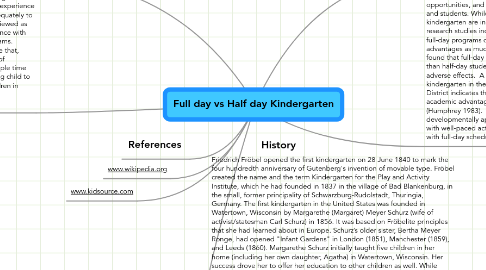Full day vs Half day Kindergarten
by Heather Schweikert

1. Many educators still prefer half-day, everyday kindergarten. They argue that a half-day program can provide high quality educational and social experience for young children while orienting them adequately to school. Specifically, half-day programs are viewed as providing continuity and systematic experience with less probability of stress than full-day programs. Proponents of the half-day approach believe that, given the 5-year-old's attention span, level of interest, and home ties, a half day offers ample time in school and allows more time for the young child to play and interact with adults and other children in less-structured home or child care settings (Finkelstein 1983).
2. www.kidsource.com
3. www.wikipedia.org
4. Friedrich Fröbel opened the first kindergarten on 28 June 1840 to mark the four hundredth anniversary of Gutenberg's invention of movable type. Fröbel created the name and the term Kindergarten for the Play and Activity Institute, which he had founded in 1837 in the village of Bad Blankenburg, in the small, former principality of Schwarzburg-Rudolstadt, Thuringia, Germany. The first kindergarten in the United States was founded in Watertown, Wisconsin by Margarethe (Margaret) Meyer Schurz (wife of activist/statesman Carl Schurz) in 1856. It was based on Fröbelite principles that she had learned about in Europe. Schurz’s older sister, Bertha Meyer Ronge, had opened "Infant Gardens" in London (1851), Manchester (1859), and Leeds (1860). Margarethe Schurz initially taught five children in her home (including her own daughter, Agatha) in Watertown, Wisconsin. Her success drove her to offer her education to other children as well. While Schurz's first kindergarten was German-language, she also advocated the establishment of English-language kindergartens. She is credited with converting Elizabeth Peabody to the Fröbel philosophy at a meeting in Boston in 1859. Later that year, Peabody founded the first English-language kindergarten in America in Boston, following Schurz's model. The first free kindergarten in America was founded in 1870 by Conrad Poppenhusen, a German industrialist and philanthropist who settled in College Point, NY, where he established the Poppenhusen Institute, still in existence today. The first publicly financed kindergarten in the United States was established in St. Louis in 1873 by Susan Blow.
5. Half Day Kindergarten
6. References
7. Herman (1984) believes full-day programs provide a relaxed, unhurried school day with more time for a variety of experiences, for screening and assessment opportunities, and for quality interaction between adults and students. While the long-term effects of full-day kindergarten are inconclusive, Stinard's review of 10 research studies indicates that students taking part in full-day programs demonstrate strong academic advantages as much as a year later (1982). Stinard found that full-day students performed as well or better than half-day students in every study with no significant adverse effects. A recent longitudinal study of full-day kindergarten in the Evansville-Vanderberg, Ohio, School District indicates that fourth graders maintained the academic advantage gained during full-day kindergarten (Humphrey 1983). School districts that have planned a developmentally appropriate, non-academic curriculum with well-paced activities have reported few problems with full-day scheduling (Evans 1984; Stinard l982).
8. Full Day Kindergarten
9. History


